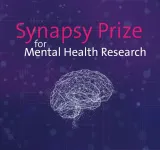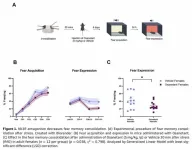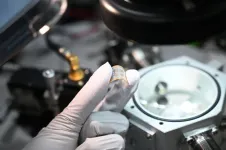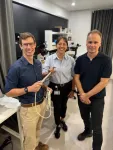Recognizing the bridge builders between neuroscience and psychiatry
A new award to recognize excellence, innovation and leadership in neurobiology research into mental health has been launched
2025-04-08
(Press-News.org)
Mental health is in crisis worldwide. While the neurosciences are advancing rapidly, psychiatry still struggles to diagnose and effectively treat many disorders. The Synapsy Center for Neuroscience and Mental Health Research at the University of Geneva, Switzerland, is launching a new international prize to reward those who bring these two worlds closer together.
A new research model is needed
Depression, schizophrenia, anxiety or bipolar disorders: psychiatric illnesses affect hundreds of millions of people worldwide and are among the leading causes of disability, suffering and mortality. Yet clinical advances remain limited. Many diagnoses still lack clear biomarkers, and treatments often remain imprecise.
This delay can be explained in part by the persistent separation between fundamental research in neuroscience and clinical practice in psychiatry. Although knowledge about the brain has advanced considerably, it is still difficult to translate this knowledge into concrete solutions for patients.
The Synapsy Center has set itself the mission of bridging this gap. Heir to the Swiss National Science Foundation's Synapsy National Center of Competence in Research (NCCR), active from 2010 to 2022, it brings together neuroscience researchers and clinical psychiatry researchers from the University of Geneva with a clear objective: to boost translational research to improve mental health.
An award to recognize bridges
In spring 2025, the Synapsy Center is launching the eponymous international prize, worth 50,000 CHF, which will be awarded for an outstanding mid- to advanced-career contribution at the intersection of neuroscience and psychiatry.
“The future of mental health research depends on closer links between the laboratory and the clinic,” emphasizes Professor Christian Lüscher, coordinator of the Synapsy Center and Chairman of the Synapsy Prize committee. “This award will highlight those who already embody this vision and whose research quality has significantly contributed to improving the understanding of psychiatric illnesses. Our hope is that this will encourage others to follow their example, e.g. the Synapsy research model.”
Call for nominations
Applications will be open from early April to June 30, 2025. Only peer nominations will be accepted. A selection will be made by a jury of Swiss experts from UNIGE, University of Lausanne and EPFL, members of the former NCCR-Synapsy, reinforced by a representative of a patient association.
The winner will be invited to the Campus Biotech in Geneva in December 2025 for a public conference and a Master Class for young researchers.
Full details will be available on the Synapsy Center website from April 2025: www.synapsy-prize.ch
END
[Attachments] See images for this press release:

ELSE PRESS RELEASES FROM THIS DATE:
2025-04-08
A new study maps how specific lactic acid bacteria can enhance both the flavour and nutritional quality of plant-based dairy alternatives. The findings may have wide-reaching perspectives for the further development of sustainable foods.
Plant-based dairy alternatives – such as soy, oat, and almond drinks – are produced without animal ingredients for consumers seeking plant-based substitutes for milk and yoghurt. However, many of these products have the similar shortcomings: flavours that do not always appeal ...
2025-04-08
A new paper in Nicotine & Tobacco Research, published by Oxford University Press, finds that a 2018 U.S. ban on smoking in public housing led to a reduction in hospitalizations for cardiovascular problems.
Tobacco use and exposure to secondhand smoke is a leading cause of preventable death in the United States. Some 480,000 Americans die every year due to tobacco. While the prevalence of adults exposed to secondhand smoke decreased dramatically between 1988 and 2014 (from 87.5% to 25.2%), about 58 million non-smokers in the U.S. experience tobacco smoke, primarily at home. Beginning in the early 2000s, ...
2025-04-08
MONTRÉAL, Québec, Canada, 8 April 2025 – In a powerful and deeply reflective Genomic Press Interview, published in Brain Medicine, Dr. Romina Mizrahi, Professor of Psychiatry at McGill University and Principal Investigator of the CaTS (Clinical and Translational Sciences) Lab at the Douglas Research Center, charts a new path forward in psychiatric research—one that begins at the molecular level.
Harnessing the power of positron emission tomography (PET), Dr. Mizrahi’s work sheds light on the invisible workings of the human brain. Where traditional psychiatric diagnosis often relies on subjective symptom clusters, her approach integrates in-vivo imaging, ...
2025-04-08
BARCELONA, Catalonia, Spain, 8 April 2025 – A new Brevia (peer-reviewed research report) published in Brain Medicine reveals that a single dose of the drug Osanetant, administered shortly after a traumatic event, significantly dampens fear expression in female mice. The findings provide strong preclinical support for using Nk3R antagonism as a sex-specific, time-sensitive intervention to reduce the risk of posttraumatic stress disorder (PTSD).
Targeting fear memory at its roots
Fear memory is a core feature of PTSD, especially when neutral cues become emotionally ...
2025-04-08
For hundreds of years, the Amazon has been exploited for its gold. Today, the precious metal is just as sought after, but the remaining tiny gold particles are much harder to find. Mining often happens in artisanal and small-scale mining operations that release mercury (Hg) into the air, polluting the environment and harming human health.
An international team of researchers has now examined tree rings of species native to the Peruvian Amazon to determine if trees could be used to show approximately where and when atmospheric mercury was released.
“We show that Ficus insipda tree cores can be used as a biomonitor for characterizing ...
2025-04-08
The research team led by Dr. Jongwon Yoon, Dr. Jeongdae Kwon, and Dr. Yonghoon Kim from the Energy & Environmental Materials Research Division at the Korea Institute of Materials Science (KIMS), has successfully developed the world’s first ammonia (NH₃) gas sensor based on a copper bromide (CuBr) film that can be fabricated through a simple solution process at low temperatures. This breakthrough technology not only enables sensor flexibility, ultra-sensitivity, and high selectivity but also significantly reduces manufacturing costs.
Ammonia gas sensors detect airborne ammonia and are utilized in indoor and outdoor ...
2025-04-08
Hot flashes, mood swings, weight gain and insomnia are all signs of hormonal changes and symptoms of menopause, when a woman no longer has menstrual cycles. They can also signal perimenopause, when the body is preparing for this next season of life.
“Perimenopause is when the menstrual cycle has started to change, and it is persistent,” explained Lauren Baker, DO, an obstetrics and gynecology physician at The Ohio State University Wexner Medical Center and certified practitioner with the Menopause Society. “The formal definition is periods fluctuate by at least seven days for at least 10 months.”
A new survey by Ohio State ...
2025-04-08
SINGAPORE – Researchers from the Agency for Science, Technology and Research (A*STAR) and the National Healthcare Group (NHG) have jointly pioneered an innovative imaging technique combining Multispectral Optoacoustic Tomography (MSOT) with artificial intelligence (AI) that could significantly improve the diagnosis and treatment of basal cell carcinoma (BCC), the most common form of skin cancer worldwide.
This advanced technique uses photoacoustic imaging (PAI), enhanced by an automated segmentation algorithm, to provide real-time, high-resolution, three-dimensional (3D) images of skin tumours. By accurately mapping tumour boundaries, ...
2025-04-08
New Australian technology is set to transform the way that gastrointestinal cancers are detected and treated with precise, minimally invasive surgery.
Backed by the Federal Government’s Economic Accelerator (AEA) Ignite Grant, researchers from the University of South Australia (UniSA) are using quantum technology to develop a first-of-its-kind laparoscopic probe that will allow surgeons to accurately map the spread of tumours.
The technology has the potential to improve cancer survival rates and patient quality of life worldwide.
Led by Dr Nicole Dmochowska from UniSA’s ...
2025-04-08
FOR IMMEDIATE RELEASE
Physicians have long observed a mystifying phenomenon: After a bout of infection or an autoimmune disease flare-up, some people experience prolonged mood swings, emotional dysregulation, and changes in behavior. But the precise connection between inflammation, mood, and behavior has remained elusive.
Now, two new studies from Harvard Medical School and Massachusetts Institute of Technology, published April 7 in Cell, detail the steps of an intricate brain-immune crosstalk that accounts for this long-known but poorly understood observation.
The work, conducted ...
LAST 30 PRESS RELEASES:
[Press-News.org] Recognizing the bridge builders between neuroscience and psychiatry
A new award to recognize excellence, innovation and leadership in neurobiology research into mental health has been launched






